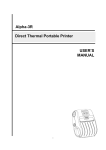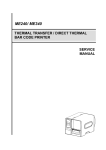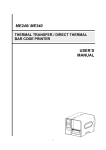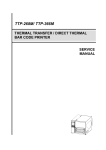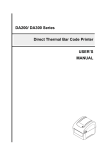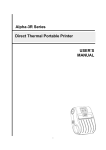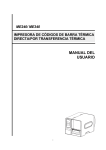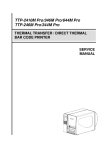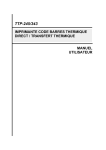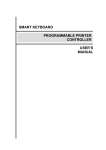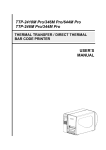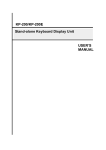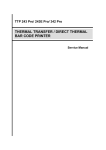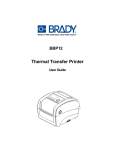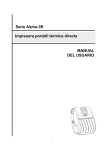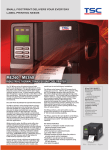Download USER`S MANUAL TA200/ TA210/ TA300/ TA310 Series
Transcript
TA200/ TA210/ TA300/ TA310 Series THERMAL TRANSFER / DIRECT THERMAL BAR CODE PRINTER USER’S MANUAL i Copyright Information © 2011 TSC Auto ID Technology Co., Ltd, The copyright in this manual, the software and firmware in the printer described therein are owned by TSC Auto ID Technology Co., Ltd, All rights reserved. CG Triumvirate is a trademark of Agfa Corporation. CG Triumvirate Bold Condensed font is under license from the Monotype Corporation. Windows is a registered trademark of Microsoft Corporation. All other trademarks are the property of their respective owners. Information in this document is subject to change without notice and does not represent a commitment on the part of TSC Auto ID Technology Co. No part of this manual may be reproduced or transmitted in any form or by any means, for any purpose other than the purchaser’s personal use, without the expressed written permission of TSC Auto ID Technology Co. ii Agency Compliance and Approvals CE CLASS A EN 55022 EN 55024 FCC CFR Title 47 Part 15 Subpart B ICES-003 Class A GB-4953 GB9254 (CLASS A) GB27625 此为 A 级产品,在生活环境中,该产品可能会造成无线电干扰,在这种 情况下,可能需要用户对干扰采取切实可行的措施。 IEC 60950-1 iii Contents 1. Introduction ................................................. 1 1.1 Product Introduction ......................................................................................... 1 1.2 Product Features ............................................................................................... 2 1.2.1 Printer Standard Features ...................................................................... 2 1.2.2 Printer Optional Features ....................................................................... 3 1.3 General Specifications ...................................................................................... 4 1.4 Print Specifications .......................................... 4 1.5 Ribbon Specifications......................................... 4 1.6 Media Specifications.......................................... 5 2. Operations Overview .......................................... 6 2.1 Unpacking and Inspection ................................................................................ 6 2.2 Printer Overview ................................................................................................ 7 2.2.1 Front View ............................................................................................... 7 2.2.2 Interior View ............................................................................................ 8 2.2.3 Rear View ................................................................................................ 2 3. Setup ...................................................... 3 3.1 Setting up the Printer ........................................................................................ 3 3.2 Loading the Ribbon........................................................................................... 4 3.3 Loading the Media ............................................................................................. 8 3.3.1 Loading the Roll Labels ......................................................................... 8 3.3.2 Loading the Media in Peel-off mode (Option) ..................................... 11 3.3.3 Loading the Media in Cutter Mode (Option) ........................................ 13 3.3.4 External Label Roll Mount Installation (Option).................................. 14 4. LED and Button Functions..................................... 16 4.1 LED Indicator ................................................................................................... 16 4.2 Regular Button Functions .............................................................................. 16 4.3 Power-on Utilities ............................................................................................ 17 4.3.1 Ribbon and Gap/Black Mark Sensor Calibration ................................ 17 4.3.2 Gap/Black Mark Calibration, Self-test and Dump Mode ..................... 18 4.3.3 Printer Initialization .............................................................................. 21 4.3.4 Set Black Mark Sensor as Media Sensor and Calibrate the Black Mark Sensor ............................................................................................................ 22 4.3.5 Set Gap Sensor as Media Sensor and Calibrate the Gap Sensor ...... 22 4.3.6 Skip AUTO.BAS .................................................................................... 23 5. Diagnostic Tool ............................................. 24 iv 5.1 Start the Diagnostic Tool ................................................................................ 24 5.2 Printer Function .............................................................................................. 25 5.3 Calibrating Media Sensor by Diagnostic Tool ...................... 26 5.3.1 Auto Calibration .................................................................................... 26 5.4 Setting Ethernet by Diagnostic Utility (Option) ..................... 27 5.4.1 Using USB interface to setup Ethernet interface................................ 27 5.4.2 Using RS-232 interface to setup Ethernet interface ........................... 28 5.4.3 Using Ethernet interface to setup Ethernet interface ......................... 29 6. Troubleshooting ............................................. 31 6.1 Common Problems ......................................................................................... 31 7. Maintenance ................................................ 34 Revise History ................................................ 35 v 1. Introduction 1.1 Product Introduction Thank you very much for purchasing TSC bar code printer. The TA200 series printer features two durable gear-driven motors that are capable of handling large capacity 300 meter ribbons and large rolls of media inside its sleek design. If the 5” interior label capacity is not enough, simply add an external media roll mount and the TA200 can easily handle 8.4” OD rolls of labels designed for expensive industrial label printers. The moveable sensor design can accept wide range of label media. All of the most frequently used bar code formats are included. Fonts and bar codes can be printed in any one of the four directions. The TA200 series printer is built-in the high quality, high performance MONOTYPE IMAGING® True Type font engine and one CG Triumvirate Bold Condensed smooth font. With flexible firmware design, user can also download the True Type Font from PC into printer memory for printing labels. Besides the scalable font, it also provides a choice of five different sizes of alphanumeric bitmap font, OCR-A and OCR-B fonts. By integrating rich features, it is the most cost-effective and high performance printer in its class! To print label formats, please refer to the instructions provided with your labeling software; if you need to write the custom programs, please refer to the TSPL/TSPL2 programming manual that can be found on the accessories CD-ROM or on TSC website at http://www.tscprinters.com Applications o o Manufacturing & Warehousing o Parcel Post Work in Progress Item Labels Instruction labels o Small Office/ Home Office Agency labels o Retail Marking Healthcare Shipping/ Receiving Labels Price tags Patient Identification Shelf labels Pharmacy Jewelry tags Specimen Identification 1.2 Product Features 1.2.1 Printer Standard Features The printer offers the following standard features. 203 dpi models ○ 300 dpi models ○ Direct thermal printing ○ ○ ABS plastic enclosure ○ ○ Position adjustable gap sensor ○ ○ Position adjustable black mark sensor ○ ○ Ribbon sensor ○ ○ Head open sensor ○ ○ USB 2.0 (full speed) interface ○ ○ 8 MB SDRAM memory ○ ○ 4 MB FLASH memory microSD memory card reader for memory expansion up to 4 GB Real time clock ○ ○ ○ ○ ○ ○ One power switch, one feed button and LED Standard industry emulations right out of the box including Eltron® and Zebra® language support Internal 8 alpha-numeric bitmap fonts Fonts and bar codes can be printed in any one of the four directions (0, 90,180, 270 degree) Internal Monotype Imaging® true type font engine with one CG Triumvirate Bold Condensed scalable font Downloadable fonts from PC to printer memory ○ ○ ○ ○ ○ ○ ○ ○ ○ ○ ○ ○ Downloadable firmware upgrades Text, bar code, graphics/image printing (Please refer to the TSPL/TSPL2 programming manual for supporting code page) ○ ○ ○ ○ Product standard feature Thermal transfer printing Supported bar code 1D bar code Code 39, Code 93, Code128UCC, Code128 subsets A,B,C, Codabar, Interleaved 2 of 5, EAN-8, EAN-13, EAN-128, UPC-A, UPC-E, EAN and UPC 2(5) digits add-on, MSI, PLESSEY, POSTNET, China POST, GS1 DataBar, Code 11 Supported image 2D bar code PDF-417, Maxicode, DataMatrix, QR code, Aztec, GS1 DataBar Composite code BITMAP, BMP, PCX (Max. 256 colors graphics) 2 1.2.2 Printer Optional Features The printer offers the following optional features. Product option feature LCD display (graphic type, 128x64 pixel) with back light Internal Ethernet print server (10/100 Mbps) interface User Dealer Factory options options options ○ - - ○ Serial RS-232C (2400-115200 bps) interface - - ○ Centronics interface - - ○ Peel-off module Guillotine cutter module (Full cut and partial cut) Paper thickness: 0.06~ 0.19mm, 500,000 cuts 0.20~ 0.25mm, 200,000 cuts - ○ - - ○ - Note: Except for the linerless cutter, all regular/heavy duty/care label cutters DO NOT cut on media with glue. External roll mount with 3” core (8.4 OD) label spindle ○ Extended plate for external roll mount ○ Bluetooth module (RS-232C interface) ○ - - KP-200 Plus keyboard display unit KU-007 Plus programmable smart keyboard display unit HCS-200 long rang CCD scanner ○ - - ○ - - ○ - - 3 1.3 General Specifications General Specifications Physical dimensions 224 mm (W) x 186 mm (H) x 294 mm (D) Weight 2.45 kg Electrical External universal switching power supply Input: AC 100-240V Output: DC 24V 2.5A, 60W Environmental condition Operation: 5 ~ 40˚C (41 ~ 104˚F), 25~85% non-condensing Storage: -40 ~ 60 ˚C (-40 ~ 140˚F), 10~90% non-condensing 1.4 Print Specifications Print Specifications Print head resolution 203 dpi models 300 dpi models 203 dots/inch (8 dots/mm) 300 dots/inch (12 dots/mm) Printing method Dot size (width x length) Print speed (inches per second) Thermal transfer and direct thermal 0.125 x 0.125 mm 0.084 x 0.084 mm (1 mm = 8 dots) (1 mm = 11.8 dots) TA200: 2, 3, 4 ips TA300:1.5, 2, 3 ips TA210: 2, 3, 4, 5 ips TA310: 1.5, 2, 3, 4 ips Print speed for peel 2, 3 ips mode & cutter mode Max. print width 108 mm (4.25”) 104 mm (4.09”) Max. print length 2,794 mm (110”) 1,016 mm (40”) 1.5 Ribbon Specifications Ribbon Specifications Ribbon outside diameter Max. 67 mm Ribbon length 300 meter Ribbon core inside diameter 1 inch (25.4 mm) Ribbon width Max. 110 mm Min. 40 mm Ribbon wound type Outside wound 4 1.6 Media Specifications Media Specifications 203 dpi models 300 dpi models Label roll capacity 127 mm (5”) OD Media type Continuous, die-cut, black mark, fan-fold, notch Media wound type Printing face outside wound & Printing face inside wound Media width (label + Max. 118 mm (4.6”) liner) Min. 25.4 mm (1.0”) Media thickness (label Max. 0.254 mm (10 mil) + liner) Min. 0.06 mm (2.36 mil) Media core diameter 25.4 mm~38 mm (1”~1.5”) Label length 10~2,794 mm (0.39”~110”) 10~1,016 mm (0.39”~40”) Note: If your label length is less than 25.4mm (1”), we recommend you to use the perforation at the gap for easier tear away. Label length (peeler Max. 152.4 mm (6”) mode) Min. 25.4 mm (1”) Label length (cutter Max. 2,794 mm (110”) Max. 1,016 mm (40”) mode) Min. 25.4 mm (1”) Min. 25.4 mm (1”) Gap height Min. 2 mm (0.09”) Black mark height Min. 2 mm (0.09”) Black mark width Min. 8 mm (0.31”) 5 2. Operations Overview 2.1 Unpacking and Inspection This printer has been specially packaged to withstand damage during shipping. Please carefully inspect the packaging and printer upon receiving the bar code printer. Please retain the packaging materials in case you need to reship the printer. Unpacking the printer, the following items are included in the carton. One printer unit One Windows labeling software/Windows driver CD disk One quick installation guide One power cord One auto switching power supply One USB interface cable Two ribbon spindle One ribbon paper core One label spindle If any parts are missing, please contact the Customer Service Department of your purchased reseller or distributor. 6 2.2 Printer Overview 2.2.1 Front View 1 2 3 4 6 5 1. LED indicator 2. Feed key 3. LCD display (Option) 4. Paper exit chute 5. Top cover open tab 6. Power switch 7 2.2.2 Interior View 1 2 3 14 7 4 13 6 12 11 OPEN 5 10 8 9 1. Printer top cover 8. Platen roller 2. Media supply spindle 9. Black mark sensor 3. Ribbon rewind hub 10. Gap sensor 4. Print head release button 11. Media guide 5. Ribbon rewind spindle 12. Media bar 6. Fixing tab 13. Ribbon supply spindle 7. Ribbon supply hub 14. Print head 8 2.2.3 Rear View 7 1 2 3 4 5 6 1. Power jack socket 2. *microSD card slot 3. Internal Ethernet interface (Option) 4. RS-232C interface (Option) 5. USB interface (USB 2.0/ Full speed mode) 6. Centronics interface (Option) 7. Rear external label entrance chute Note: The interface picture here is for reference only. Please refer to the product specification for the interfaces availability. * Recommended micro SD card specification SD card spec SD card capacity Approved SD card manufacturer V1.0, V1.1 microSD 128 MB Transcend, Panasonic V1.0, V1.1 microSD 256 MB Transcend, Panasonic V1.0, V1.1 microSD 512 MB Panasonic V1.0, V1.1 microSD 1 GB Transcend, Panasonic V2.0 SDHC CLASS 4 microSD 4 GB Panasonic V2.0 SDHC CLASS 6 microSD 4 GB Transcend - The DOS FAT file system is supported for the SD card. - Folders/files stored in the SD card should be in the 8.3 filename format. 2 3. Setup 3.1 Setting up the Printer 1. Place the printer on a flat, secure surface. 2. Make sure the power switch is off. 3. Connect the printer to the computer with the provided USB cable. 4. Plug the power cord into the AC power cord socket at the rear of the printer, and then plug the power cord into a properly grounded power outlet. Note: * Please switch OFF printer power switch prior to plug in the power cord to printer power jack. * The interface picture here is for reference only. Please refer to the product specification for the interfaces availability. 3 3.2 Loading the Ribbon 1. Open the printer top cover by pressing the top cover open tabs located on each side of the printer. 2. Insert the paper core to the ribbon rewind spindle. 3. Insert the left side of ribbon rewind spindle to the ribbon rewind hub first then insert the right side of ribbon rewind spindle to the hole at the right side of ribbon mechanism. 4 4. Push the print head release button to open the print head mechanism. 5. Insert the ribbon to the ribbon spindle. 6. Insert the left side of ribbon supply spindle to the ribbon supply hub first then insert the right side of ribbon supply spindle to the hole at the right side of ribbon mechanism. 5 7. Pull the leader of the ribbon through the print head and stick the leader of the ribbon onto the ribbon rewind paper core. 8. Turn the ribbon rewind hub until the ribbon plastic leader is thoroughly wound and the black section of the ribbon covers the print head. 9. Close the print head mechanism by both hands and make sure the latches are engaged securely. 6 Note: Please refer to videos on TSC YouTube or driver CD. Ribbon loading path Print head Ribbon rewind hub Ribbon Paper core 7 3.3 Loading the Media 3.3.1 Loading the Roll Labels 1. Open the printer top cover by pressing the top cover open tabs located on each side of the printer. 2. Insert the paper roll into the media supply spindle and use two fixing tabs to fix the paper roll onto the center of the spindle. (If your paper width is 4 inch, you can remove the fixing tabs from the supply spindle.) 3. Place the paper roll onto the paper roll mount. 8 4. Push the print head release button to open the print head mechanism. 5. Feed the paper, printing side face up, through the media bar, media sensor and place the label leading edge onto the platen roller. Move the media guides to fit the label width. Gap sensor Black mark sensor Media guide Platen roller Note: The media sensor position is moveable. Please make sure the gap or black mark is at the location where media gap/black mark will pass through for sensing. Gap sensor Black mark sensor 9 6. Close the print head mechanism by both hands and make sure the latches are engaged securely. 7. Use “Diagnostic Tool” to set the media sensor type and calibrate the selected sensor. (Start the “Diagnostic tool” Select the 1 “Printer Configuration” tab Click the “Calibrate Sensor” button ) Please refer to section 5.3. 2 Note: * Please calibrate the gap/ black mark sensor when changing media. * Please refer to videos on TSC YouTube or driver CD. Media loading path Media Gap sensor Media bar Path for outside wound Platen roller Path for inside wound Black mark sensor Media guide 10 3.3.2 Loading the Media in Peel-off mode (Option) 1. Refer to chapter 3.3.1 to install the label. Use “Diagnostic Tool” to set the media sensor type and calibrate the selected sensor. 2. Pull the label through the front of the printer and take some labels off only leave the liner. Liner Label 3. Open the peel-off cover. Feed the liner into peel-off cover slot. Liner Peel-off cover slot 11 4. Close the peel-off module. Use the DiagTool to set the peel-off mode by selecting “PEEL” option for Post-Print Action setting then click “Set” button to enable the peel-off mode. Liner 5. Close the print head mechanism and printer cover. Printer is ready for peel-off mode. 6. Press the FEED button to test. Label Liner Note: Please calibrate the gap/black mark sensor when changing media. 12 3.3.3 Loading the Media in Cutter Mode (Option) 1. Refer to chapter 3.3.1 to install the label. 2. Lead the media through the cutter paper opening. 3. Close the print head mechanism and printer cover. Use the DiagTool to set the printer for cutter mode by selecting “CUTTER” option for Post-Print Action setting then click “Set” button to enable the cutter mode. Press the FEED button to test. Note: Please calibrate the gap/black mark sensor when changing media. 13 3.3.4 External Label Roll Mount Installation (Option) 1. Use two screws to install the extended plate onto the external Extended plate label roll mount. External label roll mount 2. Attach the extended plate on the bottom of the printer. (If you purchase the external label roll mount only, just need to put it on the rear of printer for using.) 3. Insert a 3” (or 1”) label spindle into a paper roll. And install it on the external paper roll mount. 1” label spindle 3” label spindle 14 4. Feed the media through the rear external label entrance chute. 5. Refer to chapter 3.3.1 to install the label. Use “Diagnostic Tool” to set the media sensor type and calibrate the selected sensor. Note: Please calibrate the gap/black mark sensor when changing media. 15 4. LED and Button Functions This printer has one button and one three-color LED indicator. By indicating the LED with different color and pressing the button, printer can feed labels, pause the printing job, select and calibrate the media sensor, print printer self-test report, reset printer to defaults (initialization). Please refer to the button operation below for different functions. 4.1 LED Indicator LED Color Description Green/ Solid This illuminates that the power is on and the device is ready to use. Green/ Flash This illuminates that the system is downloading data from PC to memory or the printer is paused. Amber This illuminates that the system is clearing data from printer. Red / Solid This illuminates printer head open, cutter error. Red / Flash This illuminates a printing error, such as head open, paper empty, paper jam, ribbon empty, or memory error etc. 4.2 Regular Button Functions 1. Feed labels When the printer is at ready states (Green/ Solid), press the button to feed one label to the beginning of next. 2. Pause the printing job When the printer is at printing states, press the button to pause a print job. When the printer is paused the LED will be green blinking. Press the button again to continue the printing job. 16 4.3 Power-on Utilities There are six power-on utilities to set up and test printer hardware. These utilities are activated by pressing FEED button then turning on the printer power simultaneously and release the button at different color of LED. Please follow the steps below for different power-on utilities. 1. Turn off the printer power switch. 2. Hold on the button then turn on the power switch. 3. Release the button when LED indicates with different color for different functions. Power on utilities The LED color will be changed as following pattern: LED color Amber Red Amber Green Functions (5 blinks) (5 blinks) (5 blinks) 1. Ribbon sensor calibration and gap / Release Green/Amber Red/Amber Solid green (5 blinks) (5 blinks) black mark sensor calibration 2. Gap / black mark sensor calibration, Release Self-test and enter dump mode 3. Printer initialization Release 4. Set black mark sensor as media Release sensor and calibrate the black mark sensor 5. Set gap sensor as media sensor and Release calibrate the gap sensor 6. Skip AUTO.BAS Release 4.3.1 Ribbon and Gap/Black Mark Sensor Calibration Gap/black mark sensor sensitivity should be calibrated at the following conditions: 1. A brand new printer 2. Change label stock 3. Printer initialization Please follow the steps below to calibrate the ribbon and gap/black mark sensor. 1. Turn off the power switch. 2. Hold on the button then turn on the power switch. 3. Release the button when LED becomes red and blinking. (Any red will do during the 5 blinks). It will calibrate the ribbon sensor and gap/black mark sensor sensitivity. 17 The LED color will be changed as following order: Amber red (5 blinks) amber (5 blinks) green (5 blinks) green/amber (5 blinks) red/amber (5 blinks) solid green Note: Please select gap or black mark sensor by sending GAP or BLINE command to printer prior to calibrate the sensor. For more information about GAP and BLINE command, please refer to TSPL2 programming manual. 4.3.2 Gap/Black Mark Calibration, Self-test and Dump Mode While calibrate the gap/black mark sensor, printer will measure the label length, print the internal configuration (self-test) on label and then enter the dump mode. To calibrate gap or black mark sensor, depends on the sensor setting in the last print job. Please follow the steps below to calibrate the sensor. 1. Turn off the power switch. 2. Hold on the button then turn on the power switch. 3. Release the button when LED becomes amber and blinking. (Any amber will do during the 5 blinks) The LED color will be changed as following order. Amber red (5 blinks) amber (5 blinks) green (5 blinks) green/amber (5 blinks) red/amber (5 blinks) solid green 4. It calibrates the sensor and measures the label length and prints internal settings then enter the dump mode. Note: Please select gap or black mark sensor by Diagnostic Tool or by GAP or BLINE command prior to calibrate the sensor. For more information about GAP and BLINE command, please refer to TSPL2 programming manual. 18 Self-test Printer will print the printer configuration after gap/black mark sensor calibration. Self-test printout can be used to check if there is any dot damage on the heater element, printer configurations and available memory space. Self-test printout Printer model name & Main board firmware version Printer serial number Printed mileage Main board firmware checksum Serial port setting Code page Country code Print speed Print darkness Label size (width, height) Black mark or gap size (vertical gap, offset) Sensor sensitivity Ethernet settings information (option) File management information Print head test pattern Self-test printout (with printer firmware V7.0 and later version) Model name F/W version Firmware checksum Printer S/N TSC configuration file System date System time Printed mileage (meter) Cutting counter 19 Print speed (inch/sec) Print darkness Label size (inch) Gap distance (inch) Gap/black mark sensor intension Code page Country code ZPL setting information Print darkness Print speed (inch/sec) Label size Control prefix Format prefix Delimiter prefix Printer power up motion Printer head close motion Note: ® ZPL is emulating for Zebra language. RS232 serial port configuration Numbers of download files Total & available memory space Print head check pattern 20 Dump mode Printer will enter dump mode after printing printer configuration. In the dump mode, all characters will be printed in 2 columns as following. The left side characters are received from your system and right side data are the corresponding hexadecimal value of the characters. It allows users or engineers to verify and debug the program. Hex decimal data related to left ASCII Data column of ASCII data Note: 1. Dump mode requires 4” wide paper width. 2. Turn off / on the power to resume printer for normal printing. 4.3.3 Printer Initialization Printer initialization is used to clear DRAM and restore printer settings to defaults. The only one exception is ribbon sensitivity, which will note be restored to default. Printer initialization is activated by the following procedures. 1. Turn off the power switch. 2. Hold on the button then turn on the power switch. 3. Release the button when LED turns green after 5 amber blinks. (Any green will do during the 5 blinks). The LED color will be changed as following: Amber red (5 blinks) amber (5 blinks) green (5 blinks) green/amber (5 blinks) red/amber (5 blinks) solid green 21 Printer configuration will be restored to defaults as below after initialization. Parameter Speed Default setting 101.6 mm/sec (4 ips) (203DPI) 76 mm/sec (3 ips) (300DPI) Density 8 Label Width 4” (101.5 mm) Label Height 4” (101.5 mm) Sensor Type Gap sensor Gap Setting 0.12” (3.0 mm) Print Direction 0 Reference Point 0,0 (upper left corner) Offset 0 Tear Mode On Peel off Mode Off Cutter Mode Off Serial Port Settings 9600 bps, none parity, 8 data bits, 1 stop bit Code Page 850 Country Code 001 Clear Flash Memory No IP Address DHCP 4.3.4 Set Black Mark Sensor as Media Sensor and Calibrate the Black Mark Sensor Please follow the steps as below. 1. Turn off the power switch. 2. Hold on the button then turn on the power switch. 3. Release the button when LED turns green/amber after 5 green blinks. (Any green/amber will do during the 5 blinks). The LED color will be changed as following: Amber red (5 blinks) amber (5 blinks) green (5 blinks) green/amber (5 blinks) red/amber (5 blinks) solid green 4.3.5 Set Gap Sensor as Media Sensor and Calibrate the Gap Sensor Please follow the steps as below. 1. Turn off the power switch. 2. Hold on the button then turn on the power switch. 22 3. Release the button when LED turns red/amber after 5 green/amber blinks. (Any red/amber will do during the 5 blinks). The LED color will be changed as following: Amber red (5 blinks) amber (5 blinks) green (5 blinks) green/amber (5 blinks) red/amber (5 blinks) solid green 4.3.6 Skip AUTO.BAS TSPL2 programming language allows user to download an auto execution file to flash memory. Printer will run the AUTO.BAS program immediately when turning on printer power. The AUTO.BAS program can be interrupted without running the program by the power-on utility. Please follow the procedures below to skip an AUTO.BAS program. 1. Turn off printer power. 2. Press the FEED button and then turn on power. 3. Release the FEED button when LED becomes solid green. The LED color will be changed as following: Amber red (5 blinks) amber (5 blinks) green (5 blinks) green/amber (5 blinks) red/amber (5 blinks) solid green 4. Printer will be interrupted to run the AUTO.BAS program. 23 5. Diagnostic Tool TSC’s Diagnostic Utility is an integrated tool incorporating features that enable you to explore a printer’s settings/status; change a printer’s settings; download graphics, fonts and firmware; create a printer bitmap font; and send additional commands to a printer. With the aid of this powerful tool, you can review printer status and settings in an instant, which makes it much easier to troubleshoot problems and other issues. 5.1 Start the Diagnostic Tool 1. Double click on the Diagnostic tool icon to start the software. 2. There are four features (Printer Configuration, File Manager, Bitmap Font Manager, Command Tool) included in the Diagnostic utility. Features tab Interface Printer functions Printer setup Printer Status 24 5.2 Printer Function 1. Select the PC interface connected with bar code printer. 2 1 The default interface setting is USB interface. If USB interface is connected with printer, no other settings need to be changed in the interface field. 2. Click the “Printer Function” button to setup. 3. The detail functions in the Printer Function Group are listed as below. Function Description Calibrate the sensor specified in the Printer Setup group media sensor field Setup the IP address, subnet mask, gateway for the on board Ethernet Calibrate Sensor Ethernet Setup RTC Setup Synchronize printer Real Time Clock with PC Print Test Page Print a test page Reset Printer Reboot printer Factory Default Initialize the printer and restore the settings to factory default. (Please refer section 4.3.3) Dump Text To activate the printer dump mode. Ignore AUTO.BAS Ignore the downloaded AUTO.BAS program Configuration Page Print printer configuration (Please refer section 4.3.2) Password Setup Set the password to protect the settings For more information about Diagnostic Tool, please refer to the diagnostic utility quick start guide in the CD disk \ Utilities directory. 25 5.3 Calibrating Media Sensor by Diagnostic Tool 5.3.1 Auto Calibration 1. Make sure the media is install ready and print head mechanism is closed. (Please refer to section 3.3.) Note: The media sensor position is moveable. Please make sure the gap (▽) or black mark is at the location where media gap/black mark will pass through for sensing. Gap sensor Black mark sensor 2. Turn on the printer power switch. 3. Open Diagnostic tool and set interface. (The default setting is USB.) 2 1 The default interface setting is USB interface. If USB interface is connected with printer, no other settings need to be changed in the interface field. 4. Click the “Calibrate Sensor” button. 5. Select the media type and click the “Calibrate” button. 1 2 26 5.4 Setting Ethernet by Diagnostic Utility (Option) The Diagnostic Utility is enclosed in the CD disk \Utilities directory. Users can use Diagnostic Tool to setup the Ethernet by RS-232, USB and Ethernet interfaces. The following contents will instruct users how to configure the Ethernet by these three interfaces. 5.4.1 Using USB interface to setup Ethernet interface 1. Connect the USB cable between the computer and the printer. 2. Turn on the printer power. 3. Start the Diagnostic Utility by double clicking on the icon. 4. The Diagnostic Utility default interface setting is USB interface. If USB interface is connected with printer, no other settings need to be changed in the interface field. 5. Click on the “Ethernet Setup” button from “Printer Function” group in Printer Configuration tab to setup the IP address, subnet mask and gateway for the on board Ethernet. 27 5.4.2 Using RS-232 interface to setup Ethernet interface 1. Connect the computer and the printer with a RS-232 cable. 2. Turn on the printer power. 3. Start the Diagnostic Utility by double clicks on the icon. 4. Select “COM” as interface then click on the “Setup” button to setup the serial port baud rate, parity check, data bits, stop bit and flow control parameters. 5. Click on the “Ethernet Setup” button from printer function of Printer Configuration tab to setup the IP address, subnet mask and the gateway for the on board Ethernet. 28 5.4.3 Using Ethernet interface to setup Ethernet interface 1. Connect the computer and the printer to the LAN. 2. Turn on the printer power. 3. Start the Diagnostic Utility by double clicks on the icon. 4. Select “Ethernet” as the interface then click on the “Setup” button to setup the IP address, subnet mask and gateway for the on board Ethernet. 5. Click the “Discover Device” button to explore the printers that exist on the network. 6. Select the printer in the left side of listed printers, the correspondent IP address will be shown in the right side “IP address/Printer Name” field. 7. Click “Change IP Address” to configure the IP address obtained by DHCP or static. The default IP address is obtained by DHCP. To change the setting to static IP address, click “Static IP” radio button then enter the IP address, subnet mask and gateway. Click “Set IP” to take effect the settings. 29 Users can also change the “Printer Name” by another model name in this fields then click “Set Printer Name” to take effect this change. Note: After clicking the “Set Printer Name” or “Set IP” button, printer will reset to take effect the settings. 8. Click “Exit” button to exit the Ethernet interface setup and go back to Diagnostic Tool main screen. Factory Default button This function will reset the IP, subnet mask, gateway parameters obtained by DHCP and reset the printer name. Web setup button Except to use the Diagnostic Utility to setup the printer, you can also explore and configure the printer settings and status or update the firmware with the IE or Firefox web browser. This feature provides a user friendly setup interface and the capability to manage the printer remotely over a network. 30 6. Troubleshooting 6.1 Common Problems The following guide lists the most common problems that may be encountered when operating this bar code printer. If the printer still does not function after all suggested solutions have been invoked, please contact the Customer Service Department of your purchased reseller or distributor for assistance. Problem Power indicator does not illuminate Possible Cause Recovery Procedure * The power cord is not properly connected. * Plug the power cord in printer and outlet. * Switch the printer on. * The printer carriage is open. * Please close the print carriage. * Running out of ribbon. * The ribbon is installed incorrectly. * Supply a new ribbon roll. * Please refer to the steps on section 3.2 to re-install the ribbon. - The printer status from DiagTool shows “Head Open”. - The LCD shows “Carriage Open”. - The printer status from DiagTool shows “Ribbon End Err.” Or “Ribbon Encoder Err.” - The LCD shows “No Ribbon”. - The printer status from DiagTool shows “Out of Paper”. - The LCD shows “No Paper”. * Running out of label. * Supply a new label roll. * The label is installed * Please refer to the steps on section 3.3 to incorrectly. reinstall the label roll. * Gap/black mark sensor is not * Calibrate the gap/black mark sensor. calibrated. * Gap/black mark sensor is not set properly. * Make sure label size is set * Calibrate the gap/black mark sensor. DiagTool shows “Paper Jam”. properly. * Set label size correctly. - The LCD shows “Paper Jam”. * Labels may be stuck inside the printer mechanism. * If the peel-off module is installed, please remove the label. * If there is no peel-off module in front of the printer, please switch off the printer and - The LCD shows “Take Label”. * Peel-off function is enabled. install it. * Check if the connector is plugging correctly. - The printer status from 31 Not Printing Memory full ( FLASH / DRAM ) microSD card is unable to use Poor Print Quality Cutter is not working * Re-connect cable to interface. * If using serial cable, - Please replace the cable with pin to pin connected. - Check the baud rate setting. The default baud rate setting of printer is 9600,n,8,1. * If using the Ethernet cable, - Check if the Ethernet RJ-45 connector green LED is lit on. - Check if the Ethernet RJ-45 connector amber LED is blinking. - Check if the printer gets the IP address when using DHCP mode. * Cable is not well connected to Check if the IP address is correct when serial or USB interface or using the static IP address. parallel port. Wait a few seconds let the printer get the * The serial port cable pin communication with the server then configuration is not pin to pin check the IP address setting again. connected. * Chang a new cable. * Ribbon and media are not compatible. * Verify the ribbon-inked side. * Reload the ribbon again. * Clean the print head. * The print density setting is incorrect. * Print head’s harness connector is not well connected with printheat. Turn off the printer and plug the connector again. * Check your program if there is a command PRINT at the end of the file and there must have CRLF at the end of each command line. * Delete unused files in the FLASH/DRAM. * The max. numbers of DRAM is 256 files. * The max. user addressable memory space * The space of FLASH/DRAM of DRAM is 256KB. is full. * The max. numbers of file of FLASH is 256 files. * The max. user addressable memory space of FLASH is 2560KB. * microSD card is damaged. * Use the supported capacity microSD card. * microSD card doesn’t insert * Insert the microSD card again. correctly. * The supported microSD card spec and the * Use the non-approved approved microSD card manufacturers, microSD card manufacturer. please refer to section 2.2.3. * Ribbon and media is loaded * Reload the supply. incorrectly * Clean the print head. * Dust or adhesive * Clean the platen roller. accumulation on the print * Adjust the print density and print speed. head. * Run printer self-test and check the print * Print density is not set head test pattern if there is dot missing in properly. the pattern. * Printhead element is * Change proper ribbon or proper label damaged. media. * Ribbon and media are * The print head mechanism does not latch incompatible. the print head properly. * The printhead pressure is not set properly. * Plug in the connect cable correctly. * The connector is loose. * Remove the label. * Cutter jam. * Make sure the thickness of label is less * Cutter PCB is damaged. than 0.19 mm. * Replace a cutter driver IC board. 32 Skip labels when printing * Label size is not specified * Check if label size is setup correctly. properly. * Calibrate the sensor by Auto Gap or * Sensor sensitivity is not set Manual Gap options. properly. * Clear the GAP/Black mark sensor by * The media sensor is covered blower. with dust. * Calibrate the sensor sensitivity again. * Set the correct label size and gap size. * If using the software BarTender, please set the vertical offset in the driver. * Media sensor sensitivity is not set properly. The printing position of small * Label size is incorrect. * The parameter Shift Y in the label is incorrect LCD menu is incorrect. * The vertical offset setting in the driver is incorrect. Missing printing on the left or right side of label RTC time is incorrect when * Wrong label size setup. * Set the correct label size. * The battery has run down. * Check if there is a battery on the main board. reboot the printer * Ribbon installation is incorrect. * Media installation is incorrect. Wrinkle problem * Print density is incorrect. * Media feeding is incorrect. * The print head is dirty. Gray line on the blank label * The platen roller is dirty. * The printer is in Hex Dump mode. Irregular printing * The RS-232 setting is incorrect. 33 * Please set the suitable density to have good print quality. * Make sure the label guide touch the edge of the media guide. * Clean the print head. * Clean the platen roller. * Turn off and on the printer to skip the dump mode. * Re-set the Rs-232 setting. 7. Maintenance This session presents the clean tools and methods to maintain your printer. 1. Please use one of following material to clean the printer. Cotton swab Lint-free cloth Vacuum / Blower brush 100% ethanol 2. The cleaning process is described as following, Printer Part Method 1. Always turn off the printer before cleaning the print head. 2. Allow the print head to cool for a minimum of one minute. 3. Use a cotton swab and 100% ethanol to clean the print head surface. Interval Clean the print head when changing a new label roll Print Head 1. Turn the power off. 2. Rotate the platen roller and wipe it Platen Roller thoroughly with 100% ethanol and a cotton swab, or lint-free cloth. Use the lint-free cloth with 100% Tear Bar/Peel Bar ethanol to wipe it. Compressed air or vacuum Sensor Wipe it with water-dampened cloth Exterior Interior Brush or vacuum Clean the platen roller when changing a new label roll As needed Monthly As needed As needed Note: Do not touch printer head by hand. If you touch it careless, please use ethanol to clean it. Please use 100% Ethenol. DO NOT use medical alcohol, which may damage the printer head. Regularly clean the print head and supply sensors once change a new ribbon to keep printer performance and extend printer life. 34 Revise History Date 2012/4/2 2012/5/8 2012/8/30 2013/4/2 Content Editor Camille Update chapter 1.6 Modify ribbon and media loading path drawings (Add the media Camille path for inside wound type) Update chapter 1.4 Camille Modify section 1.2.2 (cutter spec) Camille Modify section 4.3.2 (V7.0 F/W self test) Add TSC YouTube web address 2013/9/27 Modify section 1.2 Camille Modify section 2.2.3 2014/4/14 Modify agency compliance and approvals Camille 2014/10/27 Add TA210/TA310 models Camille 35 36 TSC Auto ID Technology Co., Ltd. Corporate Headquarters 9F., No.95, Minquan Rd., Xindian Dist., New Taipei City 23141, Taiwan (R.O.C.) TEL: +886-2-2218-6789 FAX: +886-2-2218-5678 Web site: www.tscprinters.com E-mail: [email protected] [email protected] 37 Li Ze Plant No.35, Sec. 2, Ligong 1st Rd., Wujie Township, Yilan County 26841, Taiwan (R.O.C.) TEL: +886-3-990-6677 FAX: +886-3-990-5577

















































